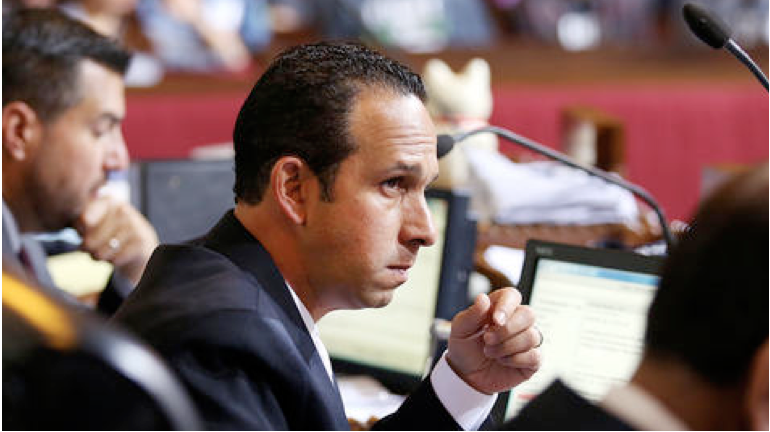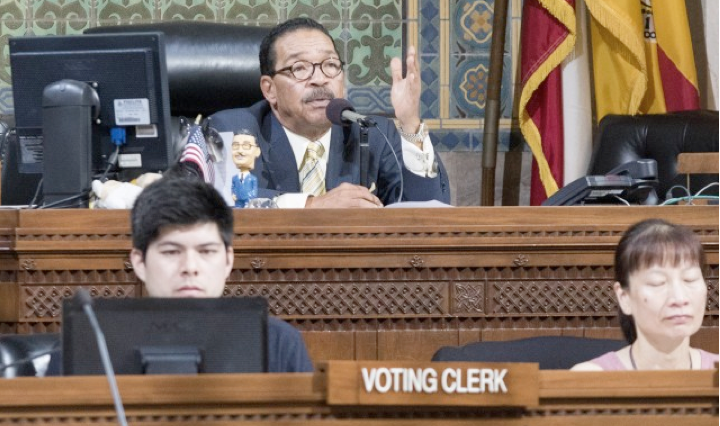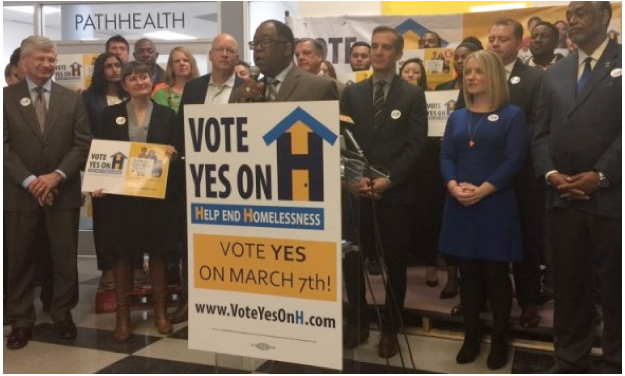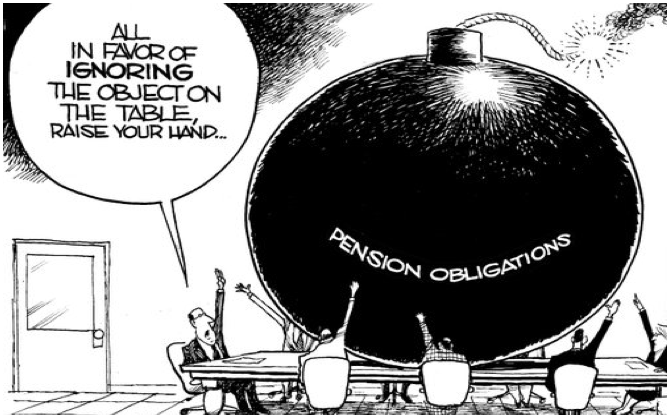EDUCATION POLITICS--Is it true there are LAUSD board candidates “supported by” Betsy DeVos?
Recently this very central, very arresting question was posted to a neighborhood social media website, highlighting the core themes of today’s political perplexity: culpability, association and formal logic.
The thread claimed that those who opposed DeVos should be aware that two carbon copy candidates running in tandem for the LAUSD fourth board district are “supported by” DeVos; today’s mail insisted the same.
“Not True” howled the pair’s supporters and indeed I have found no trace that DeVos has funded either candidate directly.
And yet these underlying claims of equivalency are, I believe, spot on.
Why?
Well first, the term “DeVos” has become iconic, representing an attitude, a political ideology and stance. As well, she has become symbolic of Trump’s predilection for appointing cabinet members who are patently antagonistic to that department which they are tapped to lead.
As unpleasant as the second characteristic is, DeVos’ symbolism is only a secondary characteristic of LAUSD’s board race for the fourth district (BD4). There is little question that incumbent Steve Zimmer is eminently – and the most – qualified candidate for this position. He has done the job for two terms already and arguably has been extremely effective at it, having climbed a very steep learning curve of mind-boggling complexity. Governing Los Angeles Unified is a gigantic job, so (i) working within a splinter school district just a very small fraction of its size, or (ii) tilting ineffectively against its entrenched bureaucracy (the twinned challenger’s qualifications respectively), does not constitute robust qualification for the post. This district is vast and its issues tremendously difficult to master; job familiarity is a strong asset.
Additionally his opponents champion the charter school ethos underwritten by Eli Broad in “a bold plan to expand the charter sector to serve 50% of Los Angeles public school students.” If such a plan cannibalizes the very system that spawned it, then these candidates could be said to be akin to the DeVos paradigm of anti-leadership because their ascension will destroy that which they are charged with directing.
However these would still be characteristics supported “by“ DeVos in only a derivative sense.
Steve Zimmers’ opponents are more directly supported by DeVos in the first, iconic, sense wherein she represents an enormously wealthied class, functioning as a special interest group in and of herself and her corporatized family. Their enormous wealth is employed toward parochial interests. She represents a numerically small but supremely vast elite that strong-arm elected officials and governance through the bully pulpit of campaign donations.
And make no doubt about it, the forces allied with charterizing America are an array of privateers that play for keeps just as DeVos’ compatriots; our very president explained this system plainly.
One of the biggest of these Education brokers operates right here in Los Angeles. Peering into the not-Zimmer initiative exposes big money focused on deposing the education of our little ones, on a scale that can only be described as fearsome. It is the same eclipsing support that swept Betsy De Vos into office despite patent nonqualification and ideological impropriety. And it harnesses the same cast of characters.
The national triumvirate of Education ®eform is framed by the Foundations of Bill and Melinda Gates, the Walton family, and Los Angeles’ Eli and Edythe Broad.
Both Broads have given both anti-Zimmer candidates separately the maximum in personal contributions, $2,200. Since 1998 they have contributed $29,700 to the personal campaigns of 12 LAUSD board members, all enthusiastic supporters of the Broad agenda (Garcia, Rodriguez, Galatzan, Gomez, Melvoin, Polhill, Johnson, Lee, Hudley-Hayes, Anderson, Sanchez, Vladovic; in descending order of largesse). For reference the couple or their businesses have contributed a total of $169K to the personal campaigns of local politicians in 236 increments below $1,100 each. This is approximately 0.0023% of Eli Broad’s estimated $7.4b net worth, which qualifies him as of 2015 as America’s 58th-wealthiest individual.
That’s nevertheless a lot of tiny little influential bon-bons that add up fast. The cash-on-hand in LAUSD’s wealthy war-chests ($367,414) totals four times that ($90,200) of Zimmers’.
But the real money comes in Independent Commitees, aka PACs.
IEs come in two flavors: PRO and CON (Support and Opposition). The raft of nasty negative mailings you think you’re fielding is not an artifact of, say, sensitivity or perception. To date more money has been spent oppositionally in BD4 than supportively. And while supportive literature is about 2/3-more prevalent for Steve Zimmer, his doubled-up opposition has spent nearly 8.5 times as much in slamming out put-downs.
Yet the style of campaigning varies with the source of monies. “Labor” coalitions spend nearly 7 times as much to convey reasons you might approve a candidate; “Business interests” spend nearly 1.5 times the resources addressing the opposite side of beyond, a parade of alternative suggestions from the dark side of truth:
But the real question is: who peddles their influence through IEs; who composes these groups? As antagonists, their spending power is mismatched; “business interests” are nearly double “labor’s power”.
In reverse order of beneficence, focusing on Eli Broad simply because he is the patron of our city even while his fellow billionaires exhibit a promiscuousness for place that only the super-wealthy can afford:
The treasurer of Students For Education Reform is a 10-year veteran investor from Goldman Sachs, the group’s chair is on the board of NewSchools Venture Fund, which is heavily supported by the Broad Foundation. The group is organized in New York, with San Francisco ties.
Dick Riordan is LA’s former mayor, a republican who has massaged education politics in Los Angeles for decades, he is one of many mayors who would abolish a democratically elected school board if permitted. Unlike Eli Broad and many supporters of Education ®eform, Richard Riordan is not a billionaire, but a mere multi-millionaire. His wealth is empirically adequate all the same to the task of influence peddling here in the City of Angels.
The CA Charter Schools Association Advocates IE Committee is a conglomerate of individuals plus agglomerated committees. Since the last LAUSD election in 2013, twenty-two million dollars has been donated to this committee. Eli Broad’s individual contribution to this was $1.4m but he is also a contributing donor to many of the committee’s 11 constituent PACs. For example just one of these, EdVoice’s IE Committee, received $12.5m since 2013, $775K of which was from Eli Broad. Several other coalitions are constituted with Broad Foundation money too.
Parent-Teacher-Alliance is, as the myriad flyers littering our landfills declare, “Sponsored by California Charter Schools Association Advocates Independent Expenditure Committee”. This is not your parent’s “PTA”; it is an “alliance”, and never despite careful parroting, the “association” copyrighted over a hundred years ago.
Eli Broad’s contribution since 2013 to this corporate “name-identity theft” is $305K. And so this group is as uroboric as the rest; groups composed of groups composed of the same individuals investing in the same narrative. On a bigger scale exactly the same cast of billionaires continues to nest infinitely inside these same groups: here in this specific node, Carrie Walton Penner ($450K) and Jim Walton ($250K) of Wal-mart, Dorris Fisher ($550K) of the Gap family fortune, Michael Bloomberg ($250K), America’s 6th-wealthiest estimated at a net worth of 45 billion dollars; Reed Hastings ($1.5m), the CEO of Netflix which just so happens to have produced sensational footage of criminality reminiscent of subsequent negative campaigning against Steve Zimmer; John Scully ($200K), CEO of Apple “ipadgate” fame and “executive-in-law” of another ubiquitous Education ®eform investor, Laurene Powell Jobs, plus the ever-present Riordan ($50K).
The point is, there are thousands of these investment repositories hiding one inside another, obscuring the true reach that this small cadre of individuals hold as underwriters of Education ®eform. This is a small convenience sample of the larger financially and managerially incestuous whole. It is a schema designed for influence and speculating, not education and certainly not social welfare as is so often claimed. The convoluted structure hiding contributors masks the extent of collusion and obsession between opportunities most accurately characterized simply as capitalist bonanzas. These names which recur seemingly indefinitely suggest a capacity for political machination that is essentially unbounded.
The final, most spendy PAC, LA Students For Change, is yet another Dick Riordan vehicle for piling fuel on the anti-Zimmer offensive.
A full review of these investor’s roots reveal close ties with charter management organizations, whether nominally “For Profit” or not (e.g., KIPP, Alliance), with investment firms and hedge funds that specialize in Education instruments profiteering on our children’s natural civil right to equitable, accountable education (e.g., Oaktree Capital Management, NewSchools Venture), and with Foundations dedicated to the “vulture philanthropy” that primes this engine of economic opportunism at the expense of our – yet curiously never their – children (e.g., Broad, DeVos, Arnold).
This is the funding juggernaut that underwrites our relatively humble school board race. Those in its clutch seem unaware of the cultivated language they have incorporated and now use as their own. But this implementation of the corporate-elite’s agenda is plain to see if not in denial. This is the sense in which our school board election is recapitulating the DeVos acclamation.
The magnitude and lure of such an extensive network filled with people whose interests are antithetical to public school participants, should cause any supporter of justice to pause.
Ask yourself simply: Why? Why do the hyper-rich want to control your children’s schooling? And since the events in Washington make evident that clearly they do, consider the vulnerability of our children here to elections that inadvertently mirror this horror. Elections here as nationally, have consequences that can be anticipated and isolated with the warning we now have. It isn’t new and is therefore a maxim well worth heeding: Follow The Money. Beware associations that exact moral sacrifice. Don’t excuse slander even in alternative form. Decency is a leadership trait worth voting for.
Please vote AGAINST Crony Capitalism on the school board. Vote for Steve Zimmer. Vote for Señora-Alva or Parent-Petersen. Do not accept the dictates of our homegrown DeVos.
(Sara Roos is a politically active resident of Mar Vista, a biostatistician, the parent of two teenaged LAUSD students and a CityWatch contributor, who blogs at redqueeninla.com)
-CW




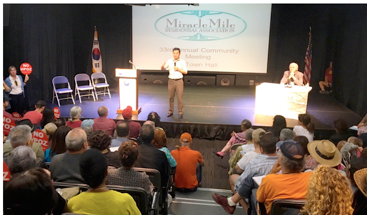 It’s a mess and Ryu (speaking to MMRA meeting photo left) is right in the middle of it. The ground has suddenly shifted from the original dispute about HPOZ boundaries -- that were reset in December by David Ambroz and the Central Planning Commission -- to Ryu now asking the very basic question, “who wants a Miracle Mile HPOZ?” Results of Ryu’s poll will be revealed at a community meeting he has called for February 22, at 7p.m. in the auditorium of John Burroughs Middle School. Both the Miracle Mile Residential Association and Say No HPOZ are mobilizing for what could be a showdown with Ryu, who is now in a tough position.
It’s a mess and Ryu (speaking to MMRA meeting photo left) is right in the middle of it. The ground has suddenly shifted from the original dispute about HPOZ boundaries -- that were reset in December by David Ambroz and the Central Planning Commission -- to Ryu now asking the very basic question, “who wants a Miracle Mile HPOZ?” Results of Ryu’s poll will be revealed at a community meeting he has called for February 22, at 7p.m. in the auditorium of John Burroughs Middle School. Both the Miracle Mile Residential Association and Say No HPOZ are mobilizing for what could be a showdown with Ryu, who is now in a tough position. 
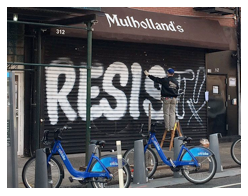 First, it is obviously important that Indivisible grows in number. It's standard to compare organizational strength to the National Rifle Association. They should make it a goal to grow to at least that size. But it's also important that the resistance to Trump's policies continue to grow outside of the big cities on the two coasts. Therefore, people who are willing to join the opposition should reach out to people who live in political border areas, the places that the news media traditionally refers to as purple (for their near balance of liberals and conservatives). Whether it's relatives or old classmates, online chums or army buddies, it's important for participants to make the effort to bring in at least one or two new people.
First, it is obviously important that Indivisible grows in number. It's standard to compare organizational strength to the National Rifle Association. They should make it a goal to grow to at least that size. But it's also important that the resistance to Trump's policies continue to grow outside of the big cities on the two coasts. Therefore, people who are willing to join the opposition should reach out to people who live in political border areas, the places that the news media traditionally refers to as purple (for their near balance of liberals and conservatives). Whether it's relatives or old classmates, online chums or army buddies, it's important for participants to make the effort to bring in at least one or two new people. 
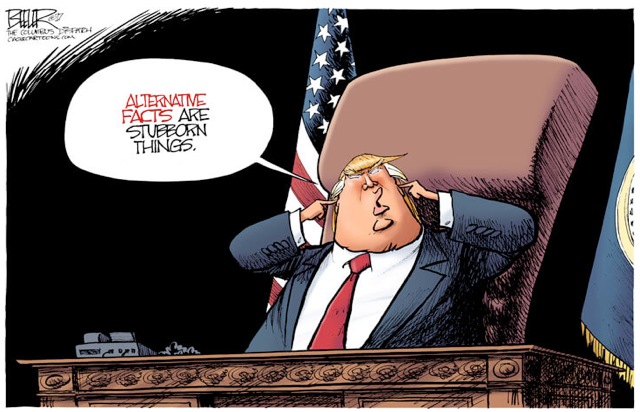



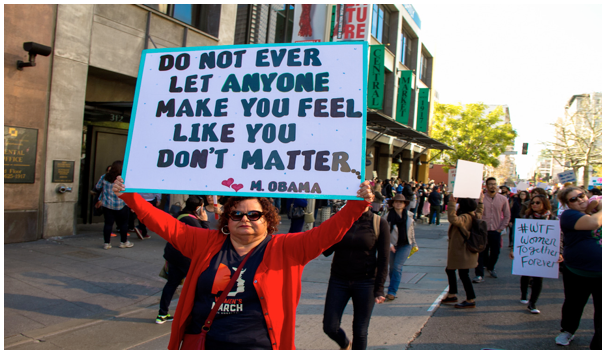
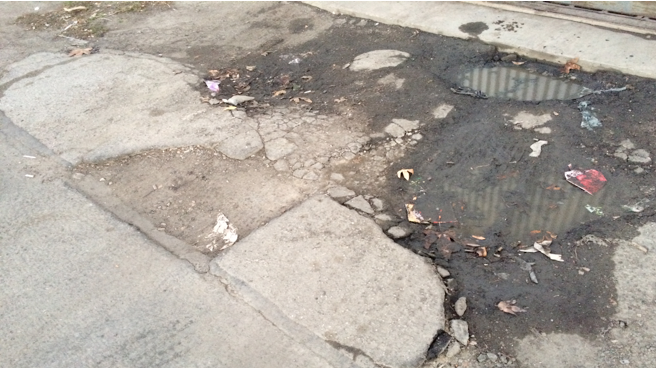
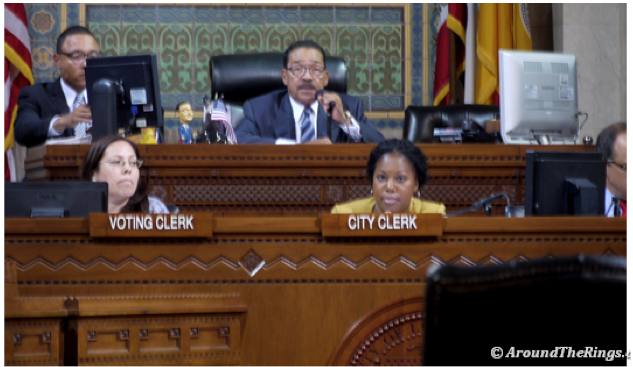
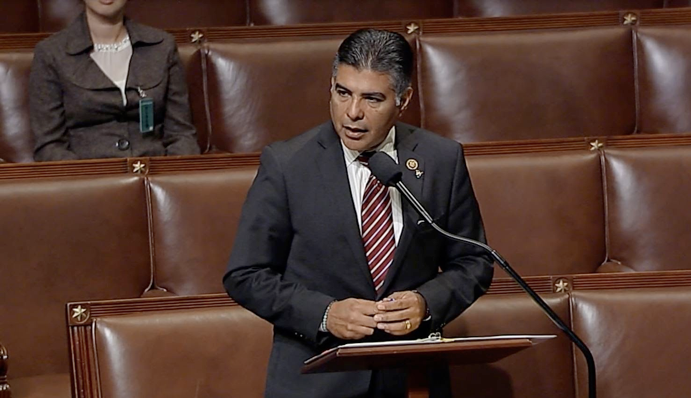
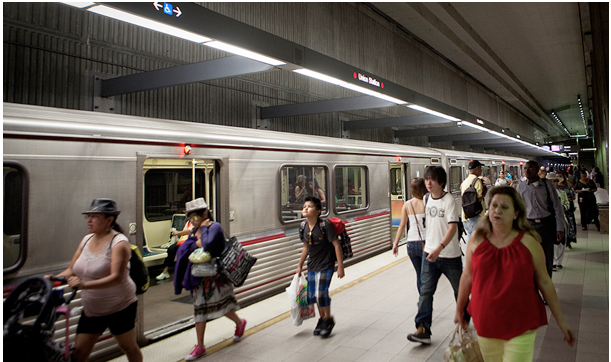
 This past month, I’ve chosen to ride the Redline downtown on several occasions. As the doors opened, students would enter beside young mothers or fathers with toddlers in strollers. Young people gave up their seats for senior citizens, arms filled with bags. During two of my trips, a young pregnant woman approached passengers for whatever change they could give her. The train truly represents a microcosm of LA life.
This past month, I’ve chosen to ride the Redline downtown on several occasions. As the doors opened, students would enter beside young mothers or fathers with toddlers in strollers. Young people gave up their seats for senior citizens, arms filled with bags. During two of my trips, a young pregnant woman approached passengers for whatever change they could give her. The train truly represents a microcosm of LA life.
 Civil rights advocates are also calling on law enforcement to help them resist an emboldened ICE agency. Many local police departments, including the Los Angeles Police Department, have
Civil rights advocates are also calling on law enforcement to help them resist an emboldened ICE agency. Many local police departments, including the Los Angeles Police Department, have 
